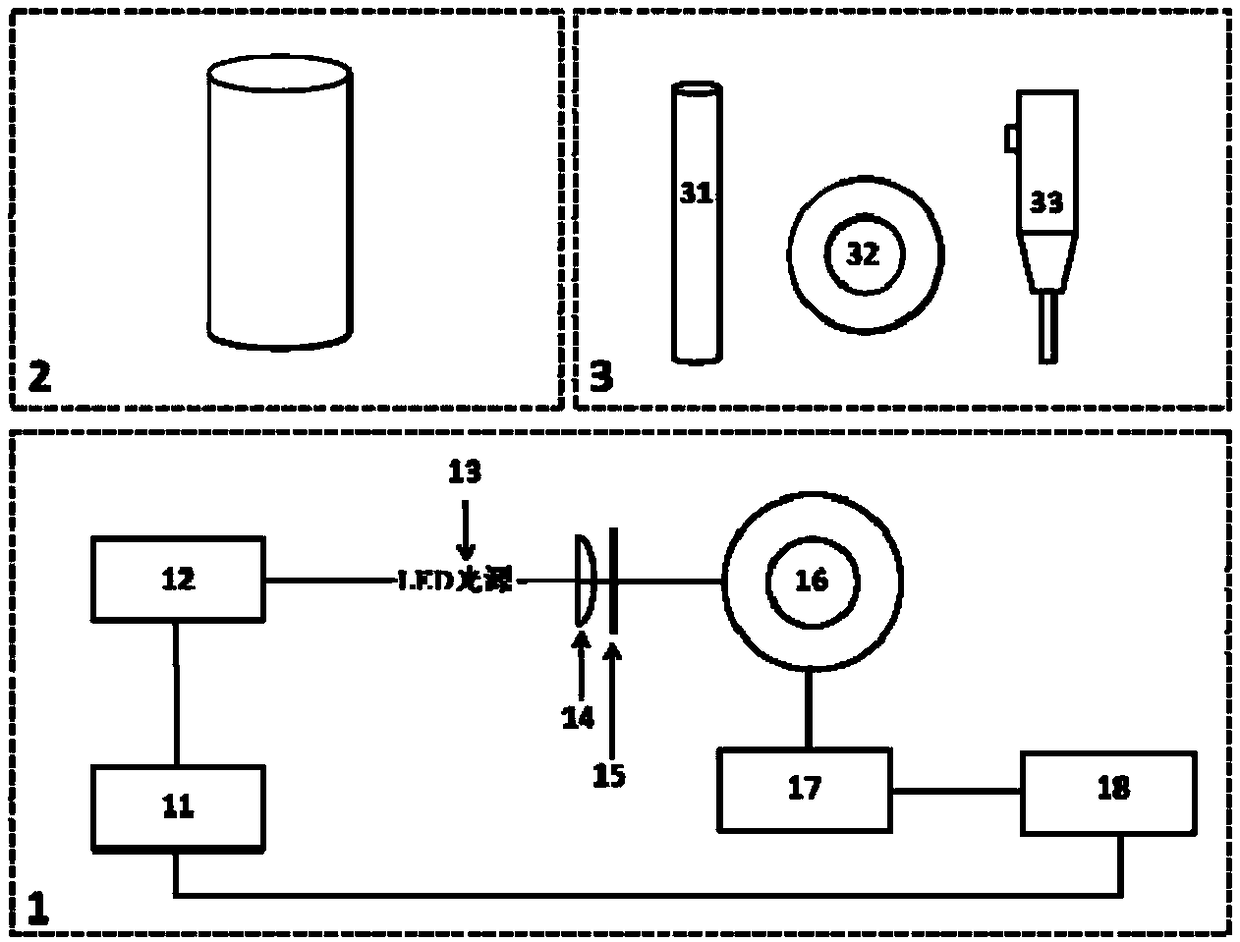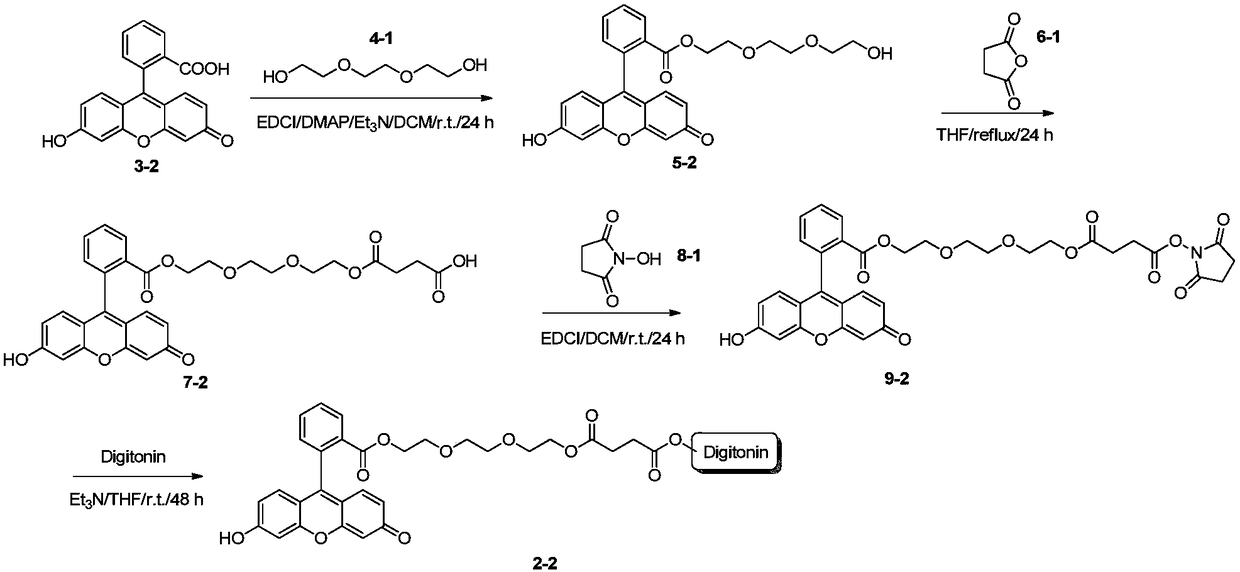Fluorescence detecting reagent, preparation method thereof and system and method for measuring skin cholesterol
A fluorescence detection and fluorescence measurement technology, used in the medical and optical fields, can solve the problems of difficult quality control, long detection time, and enzyme activity easily affected by environmental factors such as temperature and pH, so as to improve compliance and shorten detection time. Effect
- Summary
- Abstract
- Description
- Claims
- Application Information
AI Technical Summary
Problems solved by technology
Method used
Image
Examples
Embodiment 1
[0063] Such as figure 2 As shown, the synthesis of the fluorescence detection reagent 2-1 includes 7-diethylaminocoumarin-3-carboxylic acid 3-1 (261mg, 1mmol) and triethylene glycol 4-1 (1.5g, 10mmol) in EDCI [1-(3-dimethylaminopropyl)-3-ethylcarbodiimide hydrochloride] (288mg, 1.5mmol), DMAP (4-dimethylaminopyridine) (25mg, 0.2mmol ), Et 3 N(triethylamine) (152mg, 1.5mmol) and DCM (dichloromethane) (5mL) were reacted at room temperature (25°C) for 24h to obtain product 5-1 (338mg, 86%); (393mg, 1mmol) and succinic anhydride 6-1 (200mg, 2mmol) were refluxed for 24h in the presence of THF (tetrahydrofuran) (2mL) to obtain the product 7-1 (490mg, 99%); then the product 7-1 (493mg , 1mmol) and N-hydroxysuccinimide 8-1 (173mg, 1.5mmol) in EDCI [1-(3-dimethylaminopropyl)-3-ethylcarbodiimide hydrochloride] (288mg , 1.5mmol) and DCM (dichloromethane) (10mL) in the presence of the reaction to obtain the product 9-1 (550mg, 93%), the product 9-1 (12mg, 0.02mmol) and digitonin (12mg...
Embodiment 2
[0065] Such as image 3 As shown, the synthesis of the fluorescence detection reagent 2-2 includes the fluorescein 3-2 (332mg, 1mmol) and triethylene glycol 4-1 (1.5g, 10mmol) in EDCI [1-(3-dimethyl Aminopropyl)-3-ethylcarbodiimide hydrochloride] (288mg, 1.5mmol), DMAP (4-dimethylaminopyridine) (25mg, 0.2mmol), Et 3 N(triethylamine) (152mg, 1.5mmol) and DCM (dichloromethane) (5mL) were reacted at room temperature (25°C) for 24h to obtain product 5-2 (424mg, 88%); (482mg, 1mmol) and succinic anhydride 6-1 (200mg, 2mmol) were refluxed for 24h in the presence of THF (tetrahydrofuran) (2mL) to obtain the product 7-2 (580mg, 99%); then the product 7-2 (582mg , 1mmol) and N-hydroxysuccinimide 8-1 (173mg, 1.5mmol) in EDCI [1-(3-dimethylaminopropyl)-3-ethylcarbodiimide hydrochloride] (288mg , 1.5mmol) and DCM (dichloromethane) (10mL) in the presence of the reaction to obtain the product 9-2 (660mg, 94%), the product 9-2 (13mg, 0.02mmol) and digitonin (12mg, 0.01mmol ) in Et 3 N (t...
Embodiment 3
[0067] Such as Figure 4 As shown, the synthesis of the detection reagent 2-3 includes rhodamine 3-3 (444mg, 1mmol) and triethylene glycol 4-1 (1.5g, 10mmol) in EDCI [1-(3-dimethylamino Propyl)-3-ethylcarbodiimide hydrochloride] (288mg, 1.5mmol), DMAP (4-dimethylaminopyridine) (25mg, 0.2mmol), Et 3 N(triethylamine) (152mg, 1.5mmol) and DCM (dichloromethane) (5mL) were reacted to obtain product 5-3 (490mg, 85%) in the presence of conditions; then product 5-3 (576mg, 1mmol) and Succinic anhydride 6-1 (200mg, 2mmol) was refluxed in the presence of THF (tetrahydrofuran) (2mL) to obtain product 7-3 (672mg, 99%); then product 7-3 (676mg, 1mmol) and N-hydroxy Succinimide 8-1 (173mg, 1.5mmol) was dissolved in EDCI [1-(3-dimethylaminopropyl)-3-ethylcarbodiimide hydrochloride] (288mg, 1.5mmol) and DCM ( In the presence of dichloromethane) (10mL), the product 9-3 (735mg, 95%) was reacted, and the product 9-3 (16mg, 0.02mmol) and digitonin (12mg, 0.01mmol) were prepared in Et 3 N (trie...
PUM
| Property | Measurement | Unit |
|---|---|---|
| Center wavelength | aaaaa | aaaaa |
Abstract
Description
Claims
Application Information
 Login to View More
Login to View More - R&D
- Intellectual Property
- Life Sciences
- Materials
- Tech Scout
- Unparalleled Data Quality
- Higher Quality Content
- 60% Fewer Hallucinations
Browse by: Latest US Patents, China's latest patents, Technical Efficacy Thesaurus, Application Domain, Technology Topic, Popular Technical Reports.
© 2025 PatSnap. All rights reserved.Legal|Privacy policy|Modern Slavery Act Transparency Statement|Sitemap|About US| Contact US: help@patsnap.com



